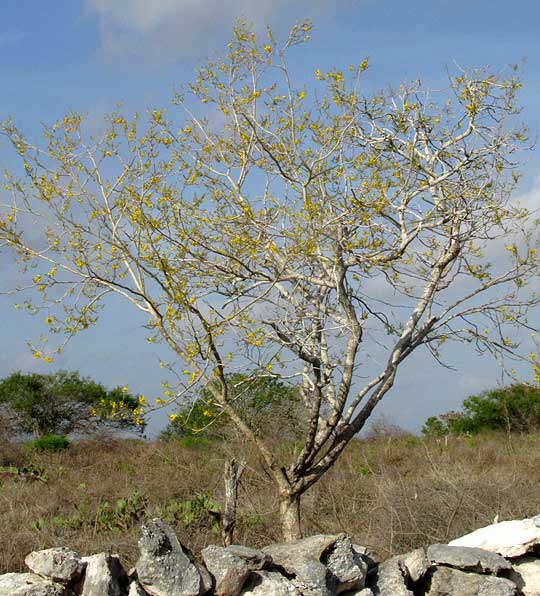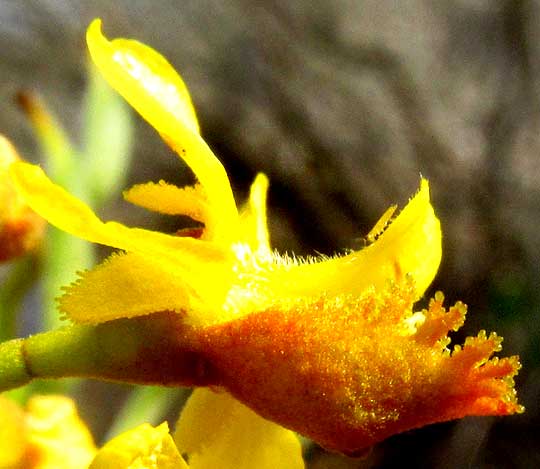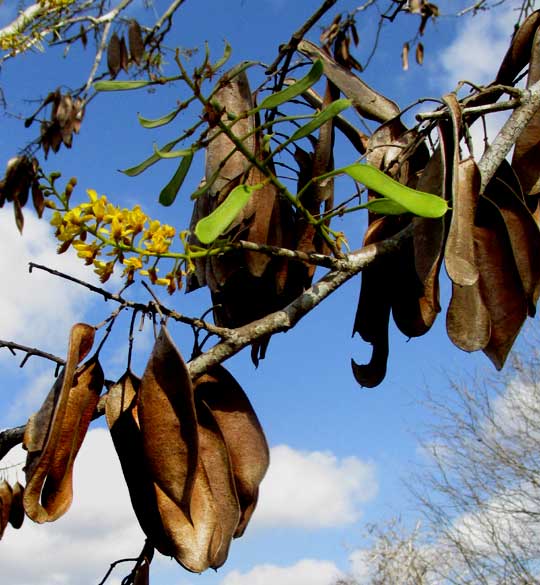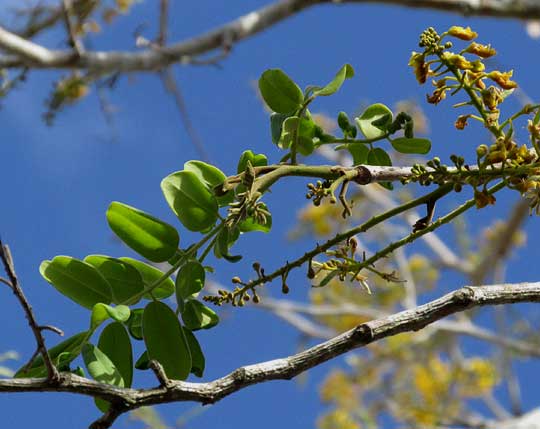Excerpts from Jim Conrad's
Naturalist Newsletter
from the May 24, 2015 Newsletter issued from Río Lagartos, on the Yucatan Peninsula's northern coast (~N21.60°, ~W88.16°), Yucatán state, MÉXICO
BRAZILETO FLOWERING
In thin soil in the savanna/ranchland zone southeast of town one of several woody species conspicuously flowering during this super dry, hot, end-of-dry-season period is the one shown below:

As with many trees during the late dry season, this species is leafless. However, in the picture below showing its raceme-type inflorescence, you can see leaves beginning to emerge from buds in anticipation of rains due later this month:

The raceme of yellow, fair-sized flowers suggests that this may be yet another senna-type tree -- a member of the Bean Family genus Senna or maybe Caesalpinia, of which several species occur here. The bilaterally symmetrical blossoms support that assumption. However, a closer look at the flowers reveals some surprises, shown :

What's that darker, deeply fringed, scoop-shaped thing in which the stamens seem to be lying? And how about the wing-like items projecting horizontally above the stamens. I've never seen anything like this in either Senna or Caesalpinia.
A close-up look at a single flower's fringed scoop from below is shown below:

In that picture we see that the scoop is a sepal, or calyx lobe, and that the blossom's other sepals also are fringed, though not so deeply. Moreover, the sepals' "teeth" bear glands of the type that elsewhere we've seen attract insects by serving as a nutrient-rich food source, known as Beltian bodies. But those were on acacia leaflets, not flower sepals, so this is quite something
Seeing all these unusual features, I began wondering if this might not even be a member of the Bean Family -- maybe something in the Milkwort or Suriana Family I hadn't heard of -- but then on other trees last season's fruit pods were found still hanging on, as shown below:

Those are classic Bean Family legume-type fruit-pods, and they even look like typical Senna or Caesalpinia fruits. Moreover, after scanning several completely leafless trees, finally one tree turned up issuing a small tuft of high-growing compound leaves, shown below:

Once again, Senna/Caesalpinia...
A good bit of sleuthing was required to figure out that this is CAESALPINIA MOLLIS*, with no English name, but often known in Spanish as Brazileto, and in Maya as Chak Te'. Best I can see, it has a strange, discontinuous distribution, occurring only in the Yucatan Peninsula and in Venezuela and Colombia in northern South America. Little information is available on the Internet about it, and hardly any photos. Identification was possible only because a herbarium in Colombia presented some dried, mounted specimens online, filed under the name Brasilettia mollis.
This unusual species has been shifted from genus to genus, not only Caesalpinia and Brasilettia but also Coulteria. Other species with such fringed-glandular sepals are known in other parts of the world, so this is a definite "kind" of tree, just that so far the experts haven't settled on what genus they should be assigned to.
What a fascinating, mysterious species. And in our area it's fairly common, just prettily doing its thing, not worrying at all about its phylogenetic affiliations, or how it got split into two such widely separated populations.